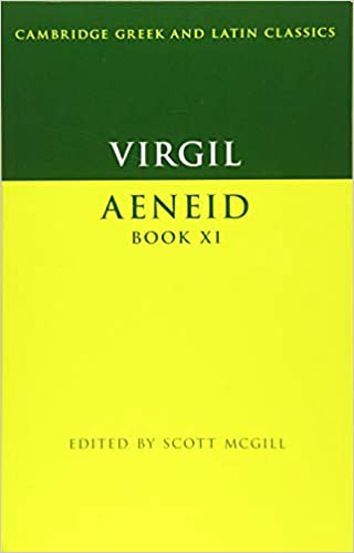
This commentary on Aeneid 11 is a triumph. It joins a learned company of recent(ish) ‘Green & Yellows’ on the oft-ignored second half of the Aeneid, spearheaded by P.R. Hardie on Aeneid 9 (1994) and R. Tarrant on Aeneid 12 (2012), and successfully holds its own (I omit K.W. Gransden's 1976 commentary on Aeneid 8, which, though still useful, needs an overhaul). Even though the epic's ‘Iliadic’ second half is often ignored in favour of the ‘Odyssean’ first half's flight out of Troy, the love-tragedy at Carthage, or Aeneas’ katabasis, these commentaries have done much to re-energise the socio-political and martial drama unfolding on Italic soil, and this new instalment on Aeneid 11 is no exception.
Its direct predecessor is Gransden's homonymous 1991 commentary in the same series; in the interim, N. Horsfall and L. Fratantuono published their tomes (respectively Virgil, Aeneid 11: A Commentary. Brill: Leiden & Boston, 2003; A Commentary on Virgil, Aeneid XI. Latomus: Brussels, 2009), while I. Gildenhard and J. Henderson published a selection for high-school use (Virgil, Aeneid 11 (Pallas & Camilla): Cambridge, 2018; available in open access via https://www.openbookpublishers.com/product/857
The Green & Yellows have evolved over the years, as has their readership, whence the need to update, revise, or replace older commentaries (cf. the brief sketch from series editor P. Easterling, ‘A Note on Cambridge Greek and Latin Classics’, in: C. Stray ed., Classical Books: Scholarship and Publishing in Britain since 1800. BICS Supplement 101 [London, 2007], 177–179). McGill wisely plots a middle course between the Scylla of Gransden's generally short notes focusing on matters of linguistics and style (perhaps too brief for modern students and too superficial for scholars) and the Charybdis of the totalising impulse of a larger commentary (elaborate discussions of Realien, literary and/or textual criticism, or the state-of-play of research). The result is a commentary that will engage (advanced) students and scholars alike.
The Introduction (pp. 1–35) is a brisk but comprehensive and highly readable tour de force which situates the events of Aeneid 11 (the funeral of Pallas, the grieving of Aeneas and Evander; the infighting of the Latin council with the weak leader Latinus, the demagogue Drances, and the incensed Turnus; the battle starring the Volscian queen Camilla) within the context of the entire poem, introducing the protagonists with their alliances and backgrounds, explaining the political stakes, and discussing significant structural patterns (notably links with Aeneid 5, but also the succession of Italic deaths – Mezentius, Camilla, Turnus – throughout books 10 to 12 and the symmetry between the deaths of Dido and Camilla). In line with the series format, this is followed by sections on metre and the constitution of the text (based on Conte's Teubner). This is followed by the text (37-65), commentary (67-281), ample bibliography (282-292), and both a subject index and index of Latin words (293-307). (Unfortunately, no index locorum: see below.)
McGill is particularly good at identifying different stylistic registers and discourses within Aeneid 11. For example, his notes on lines 313-314 explain the military and senatorial jargon in Latinus’ speech at the Latin council which serves to cast Latinus as an ineffectual leader (he talks the talk, but fails to walk the walk), while presenting the council as a proto-Roman senate meeting in which policies both foreign and domestic are discussed. Horsfall likewise notices the ‘archaic-military flavour’ of certatum est in 313, but not the senatorial tone of sententia in 314 (Gransden and Fratanuono ad loc. do not comment). Likewise, McGill neatly unpicks the emotional shifts and varying degrees of colloquialisms and more dignified language in Turnus’ speech at 376-444.
One of the features that sets McGill's commentary apart is his willingness to point out the reception of Aeneid 11 in later poetry, especially Ovid, Lucan, and the Flavian trio Valerius Flaccus, Silius Italicus, and, above all, Statius. In doing so, he follows the commendable lead of R. Hunter's Theocritus: A Selection (Cambridge, 1999), who generously provides parallels and allusions from Vergil's Eclogues. But whereas this much-valued predecessor includes an index locorum, McGill's book does not, which diminishes its use for intertextual inquiry (admittedly, nowadays much-facilitated by e.g. the Tesserae-project: https://tesserae.caset.buffalo.edu/).
The volume is well-edited, with a handful of insignificant typos and the occasional derailed sentence.Footnote 1 Something strange seems to have happened to the typesetting of my review copy: the letters are unevenly spaced throughout, which sometimes rather hampers readability. Hopefully these infelicities can be ironed out, although they in no way detract from this exciting, wide-ranging, and thought-provoking volume. May such commentaries continue to appear for the rest of the epic.


